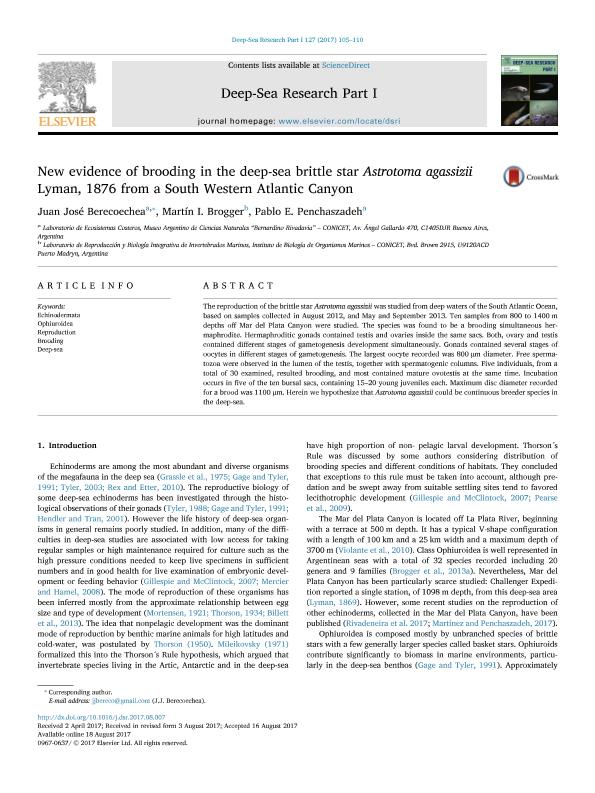Mostrar el registro sencillo del ítem
dc.contributor.author
Berecoechea, Juan José
dc.contributor.author
Brogger, Martin Ignacio

dc.contributor.author
Penchaszadeh, Pablo Enrique

dc.date.available
2018-02-28T18:53:30Z
dc.date.issued
2017-08
dc.identifier.citation
Berecoechea, Juan José; Brogger, Martin Ignacio; Penchaszadeh, Pablo Enrique; New evidence of brooding in the deep-sea brittle star Astrotoma agassizii Lyman, 1876 from a South Western Atlantic Canyon; Elsevier; Deep Sea Research Part I: Oceanographic Research Papers; 127; 8-2017; 105-110
dc.identifier.issn
0967-0637
dc.identifier.uri
http://hdl.handle.net/11336/37441
dc.description.abstract
The reproduction of the brittle star Astrotoma agassizii was studied from deep waters of the South Atlantic Ocean, based on samples collected in August 2012, and May and September 2013. Ten samples from 800 to 1400 m depths off Mar del Plata Canyon were studied. The species was found to be a brooding simultaneous hermaphrodite. Hermaphroditic gonads contained testis and ovaries inside the same sacs. Both, ovary and testis contained different stages of gametogenesis development simultaneously. The largest oocyte recorded was 800 µm diameter. Gonads contained several stages of oocytes in different stages of gametogenesis. Free spermatozoa were observed in the lumen of the testis, together with spermatogenic columns. Five individuals, from a total of 30 examined, resulted brooding, and most contained mature ovotestis at the same time. Incubation occurs in five of the ten bursal sacs, containing 15 to 20 young juveniles each. Maximum disc diameter recorded for a brood was 1120 µm. Herein we hypothesize that Astrotoma agassizii could be continuous breeder species in the deep-sea.
dc.format
application/pdf
dc.language.iso
eng
dc.publisher
Elsevier

dc.rights
info:eu-repo/semantics/openAccess
dc.rights.uri
https://creativecommons.org/licenses/by-nc-sa/2.5/ar/
dc.subject
Echinodermata
dc.subject
Ophiuroidea
dc.subject
Reproduction
dc.subject
Deep-Sea
dc.subject
Brooding
dc.subject.classification
Otras Ciencias Biológicas

dc.subject.classification
Ciencias Biológicas

dc.subject.classification
CIENCIAS NATURALES Y EXACTAS

dc.title
New evidence of brooding in the deep-sea brittle star Astrotoma agassizii Lyman, 1876 from a South Western Atlantic Canyon
dc.type
info:eu-repo/semantics/article
dc.type
info:ar-repo/semantics/artículo
dc.type
info:eu-repo/semantics/publishedVersion
dc.date.updated
2018-02-22T14:31:08Z
dc.journal.volume
127
dc.journal.pagination
105-110
dc.journal.pais
Países Bajos

dc.journal.ciudad
Amsterdam
dc.description.fil
Fil: Berecoechea, Juan José. Consejo Nacional de Investigaciones Científicas y Técnicas. Oficina de Coordinación Administrativa Parque Centenario. Museo Argentino de Ciencias Naturales ; Argentina
dc.description.fil
Fil: Brogger, Martin Ignacio. Consejo Nacional de Investigaciones Científicas y Técnicas. Centro Científico Tecnológico Conicet - Centro Nacional Patagónico. Instituto de Biología de Organismos Marinos; Argentina
dc.description.fil
Fil: Penchaszadeh, Pablo Enrique. Consejo Nacional de Investigaciones Científicas y Técnicas. Oficina de Coordinación Administrativa Parque Centenario. Museo Argentino de Ciencias Naturales ; Argentina
dc.journal.title
Deep Sea Research Part I: Oceanographic Research Papers

dc.relation.alternativeid
info:eu-repo/semantics/altIdentifier/doi/http://dx.doi.org/10.1016/j.dsr.2017.08.007
dc.relation.alternativeid
info:eu-repo/semantics/altIdentifier/url/https://www.sciencedirect.com/science/article/pii/S0967063717301231
Archivos asociados
